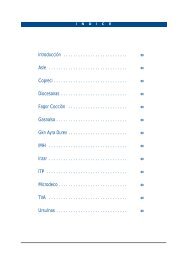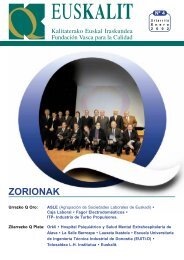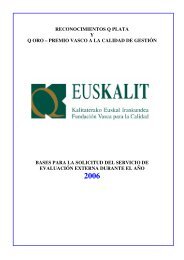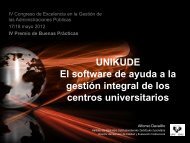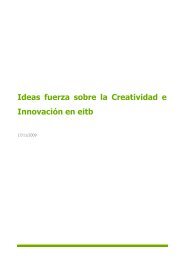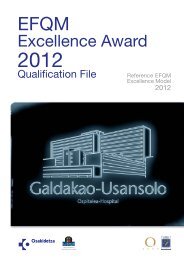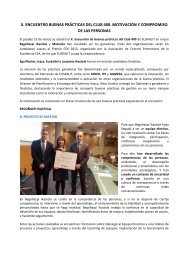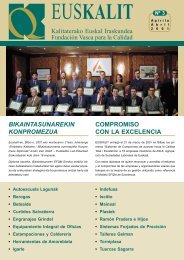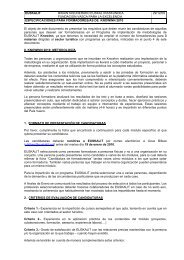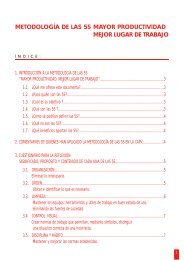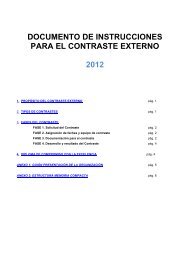Olabide Ikastola - Euskalit
Olabide Ikastola - Euskalit
Olabide Ikastola - Euskalit
You also want an ePaper? Increase the reach of your titles
YUMPU automatically turns print PDFs into web optimized ePapers that Google loves.
5 PROCESSES, PRODUCTS processes<br />
& SERVICES EFQM Excellence Award 2010 43<br />
5. PROCESSES, PRODUCTS & SERVICES<br />
5a. Processes are designed and managed to optimise<br />
stakeholder value<br />
Approach and deployment<br />
The <strong>Olabide</strong> Excellence Management System (EMS), designed<br />
for the effective delivery of our Mission statement, has enabled<br />
us to create and continuously improve the processes used to deliver<br />
our services and manage the organisation. Our pre-2009<br />
Vision statement (Overview) expressed our will to “… continuous<br />
improvement with respect to how the school is run, people<br />
satisfaction, the teaching-learning processes, multilingual<br />
education and the provision of cultural and sports activities”.<br />
This element of the Vision statement is rolled out in the Annual<br />
Business Plan (BP) through the Strategic Priority (StP) “Deeper<br />
focus on the EFQM model-based System of Excellence”, 2c,<br />
the purpose of which has been to generate a strong culture of<br />
business Excellence among our people. This has been progressively<br />
measured by obtaining a score of 621 points through selfassessment<br />
against the model in 2007-08 and being awarded the<br />
Basque Govt. Gold ‘Q-for-Quality’ in 2008.<br />
Initial training of the Management Team (MT) in Quality<br />
Management systems took place in 1994, followed in 2001-02<br />
by the presence of 7 <strong>Olabide</strong> people in the Training for Action<br />
courses run by <strong>Euskalit</strong> (Basque Foundation for Excellence) on<br />
the EFQM model. Since then, all MT members have attended<br />
successive training courses and events in relation to the EFQM<br />
Excellence model over the period 2002-10.<br />
Rather than a mere inventory of processes, the <strong>Olabide</strong> EMS<br />
is organised as a set of interrelated processes broken down and<br />
colour-coded in this submission document as follows:<br />
• Macroprocess. The system of processes covering the<br />
overall running of the organisation, encompassing how<br />
we add value for our end customers.<br />
• Process System (PS). An interrelated set of processes<br />
focused on a common purpose. Each PS has an owner.<br />
• Process Family (PF). Generally speaking, process<br />
families refer to one and the same process delivered in<br />
a slightly different way and with particular features at<br />
each education stage.<br />
• Process. A set of interrelated and repetitive activities<br />
defining how we do our work and which transform<br />
resources (an input) into products or services (an<br />
output). All processes have an owner and corresponding<br />
Management and Improvement Team (MIT).<br />
No. of<br />
systemised<br />
processes<br />
No. of<br />
procedures<br />
2002<br />
-03<br />
2003<br />
-04<br />
2004<br />
-05<br />
2005<br />
-06<br />
2006<br />
-07<br />
2007<br />
-08<br />
2008<br />
-09<br />
2009<br />
-10<br />
8 24 72 70 72 75 74 74<br />
10 10 10 9 9 9<br />
Fig. 5a.1: Number of systemised processes and procedures<br />
The <strong>Olabide</strong> intranet, 4e, provides process owners and MIT<br />
members with fast and easy password access to process data.<br />
All <strong>Olabide</strong> people have read-only access to all elements of the<br />
EMS. Each process is documented in 5 areas as described below,<br />
with the hard copy format colour-coded as shown below :<br />
1. A systemised base process, presented in a format agreed to<br />
by consensus for the whole school, which identifies:<br />
• process stakeholders (including customers/ recipients),<br />
the process Mission and its main objective (to meet the<br />
expectations of our customers through systematically<br />
managed actions), the outflow, needs and expectations of<br />
the process customer with respect to the outflow and the<br />
quality requirements of the outflow to meet those needs<br />
and expectations, all of which enables us to manage endto-end<br />
processes and all process interfaces;<br />
• process resources and, as part of process interface<br />
management, supplier processes and the quality<br />
requirements of the identified resources;<br />
• the sequence of activities and quality requirements<br />
of those activities, including a process flowchart. The<br />
quality requirements of those processes whose interfaces<br />
extend beyond the boundaries of <strong>Olabide</strong> and require<br />
the collaboration of external partners are set out and<br />
managed here;<br />
• indicators of efficiency, effectiveness and deployment, as<br />
necessary, together with their respective targets; and<br />
• those with responsibility for process management and<br />
improvement (process owner and MIT members).<br />
2. A series of complementary instructions on how to develop<br />
the process, providing guidance and help on how to conduct<br />
day-to-day activities.<br />
3. Process records, showing the end results of the different<br />
repetitions of the process.<br />
4. Process management record sheets, documenting the<br />
compliance (or not) of each completed cycle with assessment<br />
& review requirements and indicator measurement.<br />
5. A record of any and all improvement cycles conducted on<br />
the process (as a consequence of step 4).<br />
With respect to interface management, and as a consequence<br />
of a benchmarking visit to Laskorain <strong>Ikastola</strong>, in 2006 we designed<br />
a matrix to identify process interfaces which has enabled<br />
the MT to identify all internal interfaces of the <strong>Olabide</strong> EMS.<br />
The effectiveness of the matrix has been confirmed by process<br />
owners in refinement and improvement cycles. Each process<br />
owner has subsequently reviewed the corresponding definitions<br />
of supplier and customer processes to ensure coherence with<br />
the matrix.<br />
One fundamental process for managing the <strong>Olabide</strong> EMS is the<br />
Process for the Management of Continuous Improvement. This<br />
process, together with the Process for Systemising, Managing<br />
and Improving Processes, drives process management throughout<br />
the school, monitors the effectiveness of that management<br />
and generates improvement opportunities.<br />
The players involved in these processes are as follows:<br />
• Process owners: report to the MT (2c) on process management<br />
and considered as leaders in the organisation, 1b. As<br />
a result of an improvement action identified through self-assessment<br />
in 2003, all process owners have specifically defined<br />
and detailed functions, 3c. Process owners lead and are supported<br />
by a MIT.<br />
• Process Management and Improvement Teams (MIT): the<br />
team of people who provide help and support to the process<br />
owner in the management and improvement of the process.<br />
• Process participants: those involved in certain activities of the<br />
process without being process MIT members.<br />
Process owners use two mechanisms to manage their processes.<br />
Firstly, through assessment and review (refinement) actions,<br />
process owners attempt to check the degree to which the process<br />
has been deployed and identify improvement opportunities. To<br />
do so, the process owner selects a sample of process participants




